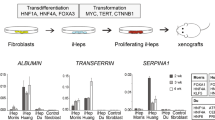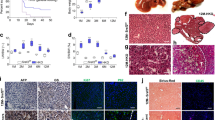Abstract
Deregulation of E2F transcriptional control has been implicated in oncogenic transformation. Consistent with this idea, we recently demonstrated that during hepatocarcinogenesis in c-myc/TGFα double transgenic mice, there is increased expression of E2F-1 and E2F-2, as well as induction of putative E2F target genes. Therefore, we generated transgenic mice expressing E2F-1 under the control of the albumin enhancer/promoter to test the hypothesis that E2F family members may contribute to liver tumor development. Overexpression of E2F-1 resulted in mild but persistent increases in cell proliferation and death during postnatal liver growth, and no increases in hepatic regenerative growth in response to partial hepatectomy. Nevertheless, from 2 months postnatally E2F-1 transgenic mice exhibited prominent hepatic histological abnormalities including preneoplastic foci adjacent to portal tracts and pericentral large cell dysplasia. From 6 to 8 months onward, there was an abrupt increase in the number of neoplastic nodules (‘adenomas’) with 100% incidence by 10 months. Some adenomas showed evidence of malignant transformation, and two of six mice killed at 12 months showed trabecular hepatocellular carcinoma. Endogenous c-myc was up-regulated in the early stages of E2F-1 hepatocarcinogenesis, whereas p53 was overexpressed in the tumors, suggesting that both E2F-1-mediated proliferation and apoptosis are operative but at different stages of hepatocarcinogenesis. In conclusion, E2F-1 overexpression in the liver causes dysplasia and tumors and suggests a cooperation between E2F-1 and c-myc oncogenes during liver oncogenesis.
This is a preview of subscription content, access via your institution
Access options
Subscribe to this journal
Receive 50 print issues and online access
$259.00 per year
only $5.18 per issue
Buy this article
- Purchase on Springer Link
- Instant access to full article PDF
Prices may be subject to local taxes which are calculated during checkout







Similar content being viewed by others
References
Bartek J, Bartkova J and Lukas J. . 1997 Exp. Cell Res. 237: 1–6.
Bartek J, Lukas J and Bartkova J. . 1999 J. Pathol. 187: 95–99.
Cartwright P, Muller H, Wagener C, Holm K and Helin K. . 1998 Oncogene 17: 611–623.
Cohen C and Berson SD. . 1986 Cancer 57: 1535–1538.
Daksis JI, Lu RY, Facchini LM, Marhin WW and Penn LJZ. . 1994 Oncogene 9: 3635–3645.
DePhino RA, Schreiber-Agus N and Alt FW. . 1991 Adv. Cancer Res. 57: 1–46.
Dynlacht BD. . 1997 Nature 389: 149–152.
Dyson N. . 1998 Genes Dev. 12: 2245–2262.
Factor VM, Jensen MR and Thorgeirsson SS. . 1997 Hepatology 26: 1434–1443.
Field SJ, Tsai FY, Kuo F, Zubiaga AM, Kaelin WGJ, Livingston DM, Orkin SH and Greenberg ME. . 1996 Cell 85: 549–561.
Frith CH and Ward JM. . 1979 J. Environ. Pathol. Toxicol. 3: 329–351.
Goyal L, McCall K, Agapite J, Hartwig E and Stellar H. . 2000 EMBO J. 19: 589–597.
Guy CT, Zhou W, Kaufman S and Robinson MO. . 1996 Mol. Cell. Biol. 16: 685–693.
Hanahan D and Weinberg RA. . 2000 Cell 100: 57–70.
Higgins GM and Anderson RM. . 1931 Arch. Pathol. 12: 186–202.
Holmberg C, Helin K, Sehested M and Karlstrom O. . 1998 Oncogene 17: 143–155.
Hunter T and Pines J. . 1994 Cell 79: 573–582.
Johnson DG. . 2000 Mol. Carcinog. 27: 151–157.
Johnson DG, Cress WD, Jakoi L and Nevins JR. . 1994 Proc. Natl. Acad. Sci. USA 91: 12823–12827.
Johnson DG, Schwarz JK, Cress WD and Nevins JR. . 1993 Nature 365: 349–352.
La Thangue NB. . 1994 Trends. Biochem. Sci. 19: 108–114.
Lukas ER, Bartley SM, Graveel CR, Diaz ZM, Dyson N, Harlow E, Yamasaki L and Farnham PJ. . 1999 Mol. Carcinog. 25: 295–303.
Macleod K. . 1999 Curr. Opin. Genet. Dev. 9: 31–39.
Macleod KF and Jacks T. . 1999 J. Pathol. 187: 43–60.
Moriya K, Fujie H, Shintani Y, Yotsuyanagi H, Tsutsumi T, Ishibashi K, Matsuura Y, Kimura S, Miyamura T and Koike K. . 1998 Nature Med. 4: 1065–1067.
Murakami H, Sanderson ND, Nagy P, Marino PA, Merlino G and Thorgeirsson SS. . 1993 Cancer Res. 53: 1719–1723.
Nagy P, Bisgaard HC, Santoni-Rugiu E and Thorgeirsson SS. . 1996 Hepatology 23: 71–79.
Nevins JR. . 1992 Science 258: 424–429.
Pierce AM, Gimenez-Conti IB, Schneider-Broussard R, Martinez LA, Conti CJ and Johnson DG. . 1998a Proc. Natl. Acad. Sci. USA 95: 8858–8863.
Pierce AM, Fisher SM, Cont CJ and Johnson DG. . 1998b Oncogene 16: 1267–1276.
Pierce AM, Schneider-Broussard R, Gimenez-Conti IB, Russell JL, Conti CJ and Johnson DG. . 1999 Mol. Cell Biol. 19: 6408–6414.
Pinkert CA, Ornitz DM, Brinster RL and Palmiter RD. . 1987 Genes Dev. 1: 268–276.
Qin XQ, Livingston DM, Kaelin WGJ and Adams PD. . 1994 Proc. Natl. Acad. Sci. USA 91: 10918–10922.
Rounbehier R, Schneider-Broussard R, Conti CJ and Johnson DJ. . 2000 Proc. American Assoc. Cancer Research 41: 394.
Santoni-Rugiu E, Jensen MR and Thorgeirsson SS. . 1998 Cancer Res. 58: 123–134.
Santoni-Rugiu E, Nagy P, Jensen MR, Factor VM and Thorgeirsson SS. . 1996 Am. J. Pathol. 149: 407–428.
Shan B and Lee WH. . 1994 Mol. Cell Biol. 14: 8166–8173.
Scherr CJ. . 1994 Cell 79: 551–555.
Sherr CJ. . 1996 Science 274: 1672–1677.
Sherr CJ and Weber JD. . 2000 Curr. Opin. Genet. Dev. 10: 94–99.
Singh P, Wong SH and Hong W. . 1994 EMBO J. 13: 3329–3338.
Solt D and Farber E. . 1976 Nature 263: 701–703.
Strauss M, Lukas J and Bartek J. . 1995 Nature Med. 1: 1245–1246.
Wang D, Russell JL and Johnson DG. . 2000 Mol. Cell. Biol. 20: 3417–3424.
Weinberg RA. . 1995 Cell 81: 323–330.
Weinberg RA. . 1996 Cell 85: 457–459.
Xu G, Livingston DM and Krek W. . 1995 Proc. Natl. Acad. Sci. USA 92: 1357–1361.
Yamasaki L. . 1999 Biochim. Biophys. Acta 1423: M9–15.
Yamasaki L, Jacks T, Bronson R, Goillot E, Harlow E and Dyson NJ. . 1996 Cell 85: 537–548.
Acknowledgements
We thank Dr William Kaelin, Dana-Farber Cancer Institute, for providing the human E2F-1 cDNa clone; Dr Nicholas C Popescu and coworkers (Molecular Cytogenetics Section, Laboratory of Experimental Carcinogenesis, NCI) for performing FISH analyses; Dr Peter Nagy (Laboratory of Experimental Carcinogenesis, NCI) for his help and advice during the course of these studies; Nancy D Sanderson for her help in generating the E2F-1 mice; and Ms Tyjen Tsai for excellent technical assistance.
This paper is a ‘United States Government Work’ paper as defined by the US Copyright Act.
Author information
Authors and Affiliations
Rights and permissions
About this article
Cite this article
Conner, E., Lemmer, E., Omori, M. et al. Dual functions of E2F-1 in a transgenic mouse model of liver carcinogenesis. Oncogene 19, 5054–5062 (2000). https://doi.org/10.1038/sj.onc.1203885
Received:
Revised:
Accepted:
Published:
Issue Date:
DOI: https://doi.org/10.1038/sj.onc.1203885
Keywords
This article is cited by
-
Cell cycle regulation in NAFLD: when imbalanced metabolism limits cell division
Hepatology International (2020)
-
Karyopherin α2-dependent import of E2F1 and TFDP1 maintains protumorigenic stathmin expression in liver cancer
Cell Communication and Signaling (2019)
-
Mouse models of hepatocellular carcinoma: an overview and highlights for immunotherapy research
Nature Reviews Gastroenterology & Hepatology (2018)
-
Selective roles of E2Fs for ErbB2- and Myc-mediated mammary tumorigenesis
Oncogene (2015)
-
Transcription addiction: can we garner the Yin and Yang functions of E2F1 for cancer therapy?
Cell Death & Disease (2014)



